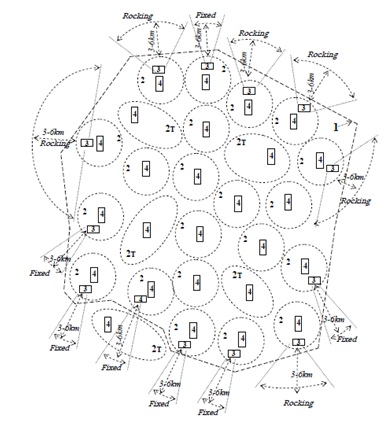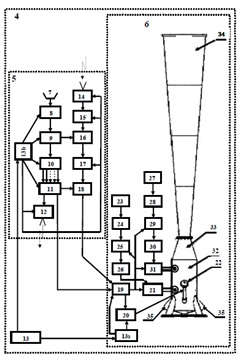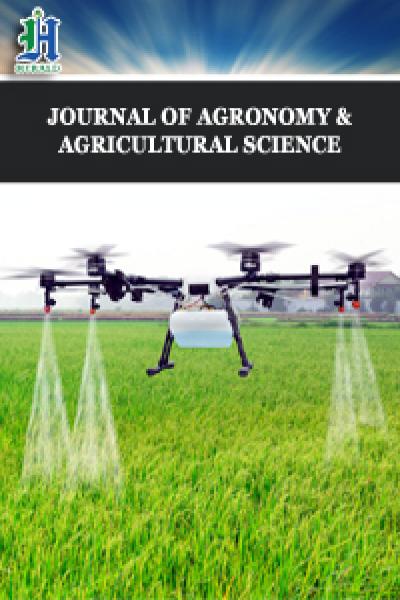
A Way to Enhance Hail Prevention Technique and to Increase the Efficiency of Anti-Hail Protection of Unlimited Agricultural Areas
*Corresponding Author(s):
Artashes K ArakelyanEcoserv Remote Observation Centre Co Ltd, 2 G. NjdehStr, #24, Yerevan, 0006, Armenia
Tel: +374 93771482,
Email:arakelyanak@yahoo.com, ecoservroc@yahoo.com
Abstract
In this article a new method and a station of anti-hail protection are described based on the early prevention of hail formation by significant shock waves, enriched by silver iodide or other reagents, allowing implement fully autonomous and automotive anti-hail protection of rural and urban areas of any size, restricted or unrestricted.
Keywords
Hail Prevention; Anti-Hail Protection; Agriculture
INTRODUCTION
CLOUDS SEEDING BY SHOCK WAVES FOR HAIL PREVENTION


The marginal sites of the protected area (1) in addition are equipped with a remote sensing complex of K far-detection (far-ranging) systems (3) spatially distributed along the edges of the protected area as shown in figure 1. The remote sensing complex which serves the whole protected area (1) of M sites is used for far-ranging detection of hail or hail generative clouds over an adjacent land all around the protected area at a horizontal distance 4-6km far from the edge (boundary) of the protected area (1) and at the altitude 3-5km, as well as for warning the anti-hail protection systems of the protected sites of the protected area (1) by transmitting on the air the warning signals on impending hail danger from a certain adjacent land of the protected area of M sites.The number K depends on the type of spatial distribution of M sites and it can have a value from the interval [1?M], e.g., if M sites are spatially distributed around a common center it will be possible to use only one (K=1) far detection system. If all M sites are located far apart as a long chain then for entire serving the protected area of M sites it will be necessary to use K=M far detection systems. Depending on the terrain relief, any of the far detection systems can be installed individually, near or at a distance from the corresponding detector-alerter, inside or outside the corresponding protection site, etc. Further actions of the chain are described in detail in [2,3]. A detailed block diagram of the far detection system is presented in [1-10].
When M=K=1 the option of figure1is performed into the outline of a version of implementation of a local network of autonomous and automatically functioning anti-hail protection of the protected site (2) of a limited size, including a restricted area like one of the marginal sitesof figure 1and one or more trapping areas (2T)[1]. Operation actions of the local network of an anti-hail protection of a locally restricted area are described in detail in [1].
1-a protected area, 2-a protected site, 2T-a trapping area, 3-a far-range detector-alerted with a scanner if necessary, 4 -an anti-hail protection system comprising a local detector alerted and a supersonic cannon (gas-generator). Sometimes, some of marginal gas-generators of figure 1and gas-generators of the trapping areas can be equipped in addition by reagent injecting facilities, which can enhance hail trapping and can make hail to fall out in trapping areas and thereby quickly neutralize hail threat. A block diagram of the anti-hail protection system (4) including the local detector-alerter and the gas-generator with reagent injecting facilities is presented in figure 2.
3-an anti-hail protection system, 5-a local detector-alerter, 6-a sonic generator, 7-an antenna, 8-a radiometric receiver, 9-a compensation device, 10-a multi-channel thresh older, 11-a warning device, 12-a transmitter, 13 (13a and 13b)-a power supply, 14-a receiver, 15-a code comparator, 16-the first controlled switcher, 17-a single-channel thresh older, 18 - the second controlled switcher, 19-a controller, 20-an ignition means, 21-a fuel injector, 22-an igniter, 23-a fuel reservoir, 24-a mechanical valve, 25-a solenoid valve, 26-a pressure regulator for a fuel, 27-a reagent reservoir, 28-a mechanical valve for a reagent, 29-a solenoid valve for a reagent, 30-a pressure regulator for a reagent, 31-a reagent injector-mixer, 32-a cylindrical combustion chamber, 33-a neck, 34-a conical barrel, 35-inlet ports.
When the far-range detector-alerter of any azimuth direction detects hail cloud or cumulonimbus coming from certain azimuth direction it warns detector-alerters of nearby located protected sites. Simultaneously it warns as well detector-alerters of the relevant trapping areas (2T) by transmitting on the air warning code-signals about impending hail danger from the certain direction. In a case if the far-range detector-alerter detects a cloud of severe hail the detector-alerters of nearby located protected sites turn-off their gas-generators to skip impending hail cloud. In opposite, the detector-alerters of the relevant trapping areas set the “alert mode” of operation for their gas-generators and start-up their gas-generators when the signals of sky brightness temperature (apparent temperatures) exceed the “alert” threshold level. Detector-alerters of the involved trapping areas turn-off their gas-generators when the corresponding far-range detector-alerters interrupt transmitting warning code signals on impending hail danger and when the levels of the signals of sky intrinsic microwave emission measured by their detector-alerters fall below the “alert” thresholds levels.
During the first few explosions, a reagent is injected into the combustion chamber of the gas-generator, which, as a result of an explosion leaves the combustion chamber through the conical barrel of the gas generator and enriching the ground level of the air with microscopic particles After that, due to the successions of significant shock waves the particles of the injected reagent, together with existed in the air positive ions are transported from ground level to cloud level.So, by this way it is possible toincrease the probability of disruption of formation of hail nuclei and to implement fully autonomous and automatic trapping of hail and to enhance protection possibilities of the above described networks of locally restricted and wide-ranging anti-hail protections.
CONCLUSION
ACKNOWLEDGEMENT
REFERENCES
- Arakelyan AK (2017) A New Approach in Hail Prevention Technique for a Locally Restricted Area. Agricultural Sciences 8: 559-571.
- Arakelyan AK (2017) A New Way to Implement Fully Autonomous and Automatic Large-Scale Anti-Hail Protection. Global Advanced Research Journal of Agricultural Science. 6: 361-373.
- Arakelyan AK (2018) Flaws and advantages of current and prospective anti-hail protection methods, stations and networks (Review). Global Advanced Research Journal of Agricultural Science 7: 366-376.
- Arakelyan AK (2013) A Method and a Network of Wide-Ranging Anti-Hail Protection, Armenian Patent # 2769, (in Armenian), Armenian.
- Arakelyan AK (2013) An Automated Wide-Ranging Anti-Hail Protection Method and a Network. Indian patent application 1598/MUMNP/2014, Bangalore, India.
- Arakelyan AK (2016) An Automated Wide-Ranging Anti-Hail Protection Method and a Network, the Patent of People’s Republic of China, # ZL2012800716222, Patentee ArtashesArakelyan, (in Chinese), China.
- Arakelyan AK (2016) An Automated Wide-Ranging Anti-Hail Protection Method and a Network, the US Patent, # 9491912, Patentee ArtashesArakelyan.
- Arakelyan AK (2017) An Automated Wide-Ranging Anti-Hail Protection Method and a Network, Canadian Patent, # 2862959, Patentee ArtashesArakelyan.
- Arakelyan AK (2017) An Automated Wide-Ranging Anti-Hail Protection Method and a Network, European Patent, # 2725893, Patentee ArtashesArakelyan.
- Arakelyan AK (2017) An Automated Wide-Ranging Anti-Hail Protection Method and a Network, Patent of the Russian Federation #2631894, Patentee ArtashesArakelyan.
Citation: Arakelyan AK (2019) A Way to Enhance Hail Prevention Technique and to Increase the Efficiency of Anti-Hail Protection of Unlimited Agricultural Areas. J Agron Agri Sci 2: 013.
Copyright: © 2019 Artashes K Arakelyan, et al. This is an open-access article distributed under the terms of the Creative Commons Attribution License, which permits unrestricted use, distribution, and reproduction in any medium, provided the original author and source are credited.

